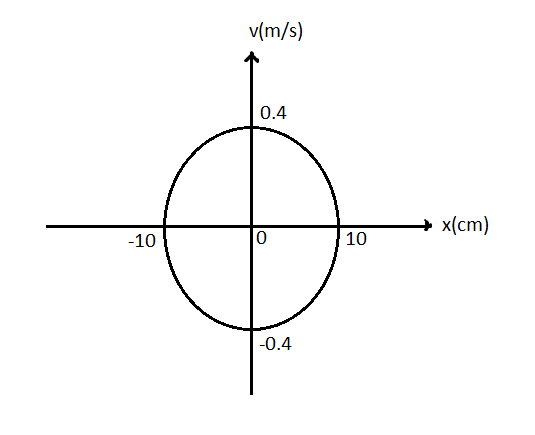
The plot velocity (v) versus displacement (x) of a particle executing simple harmonic motion in the figure. The time period of oscillation of particle is:

A) $\dfrac{\pi }{2}s$
B) $\pi s$
C) $2\pi s$
D) $3\pi s$
Answer
216k+ views
Hint:
A simple harmonic motion is an example of periodic motion. In simple harmonic motion, a particle is accelerated towards a fixed point (in this case, O) and the acceleration of the particle will be proportional to the magnitude of the displacement of the particle. We have to use the velocity and amplitude of the particle, which is given in the diagram to find the angular velocity. The time period can be calculated from that.
Formula used:
${v_{\max }} = A\omega $ (Where ${v_{\max }}$stands for the maximum velocity of the particle, $A$is the amplitude of the particle, $\omega $is the angular velocity of the particle)
$T = \dfrac{{2\pi }}{\omega }$ (Where $T$is the time period of oscillation, $2\pi $is a constant)
Complete step by step solution:
In the velocity-displacement graph given in the question, the $x$axis gives the value of displacement and the \[y\]axis gives the value of velocity.
For a simple harmonic oscillator, the maximum velocity is given by
${v_{\max }} = A\omega $
From this equation, the angular velocity can be deduced as
$\omega = \dfrac{{{v_{\max }}}}{A}$………………………..($1$)
From the graph,
The maximum displacement of the particle i.e. the amplitude,$A = 10cm$$ = 10 \times {10^{ - 2}}m$ $(\because 1cm = {10^{ - 2}}m)$
The maximum velocity of the particle, ${v_{\max }} = 0.4m/s$
Substituting the values $A$ and $\omega $ in equation ($1$)
$\omega = \dfrac{{0.4}}{{10 \times {{10}^{ - 2}}}} = 4{s^{ - 1}}$
The time period of a simple harmonic oscillator is given by,
$T = \dfrac{{2\pi }}{\omega }$
Substituting the value of $\omega $in the equation,
$T$ = $\dfrac{{2\pi }}{4} = \dfrac{\pi }{2}s$
The answer is Option (A), $\dfrac{\pi }{2}s.$
Note: The typical example of simple harmonic motion is the oscillation of a mass suspended at the end of a spring. The fixed point from which the particle starts moving is called the equilibrium position. The restoring force directed towards the equilibrium position will obey Hooke’s law. All simple harmonic motions are periodic but all periodic motions are not simple harmonic.
A simple harmonic motion is an example of periodic motion. In simple harmonic motion, a particle is accelerated towards a fixed point (in this case, O) and the acceleration of the particle will be proportional to the magnitude of the displacement of the particle. We have to use the velocity and amplitude of the particle, which is given in the diagram to find the angular velocity. The time period can be calculated from that.
Formula used:
${v_{\max }} = A\omega $ (Where ${v_{\max }}$stands for the maximum velocity of the particle, $A$is the amplitude of the particle, $\omega $is the angular velocity of the particle)
$T = \dfrac{{2\pi }}{\omega }$ (Where $T$is the time period of oscillation, $2\pi $is a constant)
Complete step by step solution:
In the velocity-displacement graph given in the question, the $x$axis gives the value of displacement and the \[y\]axis gives the value of velocity.
For a simple harmonic oscillator, the maximum velocity is given by
${v_{\max }} = A\omega $
From this equation, the angular velocity can be deduced as
$\omega = \dfrac{{{v_{\max }}}}{A}$………………………..($1$)
From the graph,
The maximum displacement of the particle i.e. the amplitude,$A = 10cm$$ = 10 \times {10^{ - 2}}m$ $(\because 1cm = {10^{ - 2}}m)$
The maximum velocity of the particle, ${v_{\max }} = 0.4m/s$
Substituting the values $A$ and $\omega $ in equation ($1$)
$\omega = \dfrac{{0.4}}{{10 \times {{10}^{ - 2}}}} = 4{s^{ - 1}}$
The time period of a simple harmonic oscillator is given by,
$T = \dfrac{{2\pi }}{\omega }$
Substituting the value of $\omega $in the equation,
$T$ = $\dfrac{{2\pi }}{4} = \dfrac{\pi }{2}s$
The answer is Option (A), $\dfrac{\pi }{2}s.$
Note: The typical example of simple harmonic motion is the oscillation of a mass suspended at the end of a spring. The fixed point from which the particle starts moving is called the equilibrium position. The restoring force directed towards the equilibrium position will obey Hooke’s law. All simple harmonic motions are periodic but all periodic motions are not simple harmonic.
Recently Updated Pages
JEE Atomic Structure and Chemical Bonding important Concepts and Tips

JEE Amino Acids and Peptides Important Concepts and Tips for Exam Preparation

Electricity and Magnetism Explained: Key Concepts & Applications

Chemical Properties of Hydrogen - Important Concepts for JEE Exam Preparation

JEE Energetics Important Concepts and Tips for Exam Preparation

JEE Isolation, Preparation and Properties of Non-metals Important Concepts and Tips for Exam Preparation

Trending doubts
JEE Main Correction Window 2026 Session 1 Dates Announced - Edit Form Details, Dates and Link

Atomic Structure: Definition, Models, and Examples

Ideal and Non-Ideal Solutions Explained for Class 12 Chemistry

Degree of Dissociation: Meaning, Formula, Calculation & Uses

Understanding Electromagnetic Waves and Their Importance

Geostationary and Geosynchronous Satellites Explained

Other Pages
Inertial and Non-Inertial Frame of Reference Explained

Clemmensen and Wolff Kishner Reductions Explained for JEE & NEET

JEE Main 2023 January 29th Shift 2 Physics Question Paper with Answer Keys and Solutions

Current Loop as a Magnetic Dipole: Concept, Derivation, and Examples

Two identical balls are projected one vertically up class 11 physics JEE_MAIN

NCERT Solutions For Class 11 Physics Chapter 13 Oscillations - 2025-26




